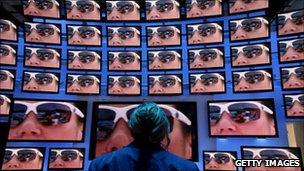The future of the living room?
- Published
- comments

Is 3D more than just a fad?
It's turning into a big week for the future of home entertainment - and more specifically how we interact with various boxes in the living room.
In Los Angeles, the giants of the games world have been unveiling new ways of making things happen on screens, while in London the UK's biggest broadcaster is taking its first nervous steps into a 3D world, external.
First, the gamers. At the E3 show, we've seen Sony, Microsoft and Nintendo all coming up with new consoles or different ways of interacting with them. The most eye-catching so far has been the Wii U, Nintendo's successor to the console which was a huge game-changing hit a few years back, but is now looking a little middle-aged.
The big idea here is a new controller with a small screen which acts as both an add-on and an alternative to your big TV screen as a venue for your game playing. You can see it as a radical reinvention of the way we use screens - or a nervous reaction to the rise of casual gaming on phones and tablet computers.
Microsoft, by contrast, is piling more and more features into Kinect, the motion control system that does away with a controller altogether. It's been showing off new features of Kinect which will allow you to talk to - or perhaps shout at - the television to do a Bing search or ask it to switch channels.
And in London, the BBC has announced its first attempt to get us all to sit on the sofa, put on some glasses, and watch 3D television.
The Wimbledon Ladies and Mens' Finals will be broadcast live in 3D on the BBC HD channel. Now BskyB and Virgin Media have both been offering 3D television for a while, but this is the first time a mass audience will be offered the chance to try the experience on a free-to-air channel, BBC HD.
So far, the jury is out on the 3D experience - in the United States recent figures suggest that 3D movies may have passed their peak in popularity. But Wimbledon has always been a place where television tries out new technology, from colour in the 1960s to interactive television and HD in recent years.
This year's experiment may help determine whether 3D is the TV technology of the future - or just a passing fad.